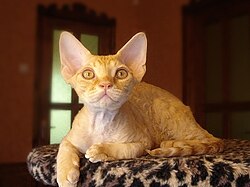| Devon Rex | |
|---|---|
 | |
| Origin | |
| Breed standards | |
| CFA | standard |
| FIFe | standard |
| TICA | standard |
| ACF | standard |
| ACFA/CAA | standard |
| CCA-AFC | standard |
| GCCF | standard |
| Domestic cat (Felis catus) | |
The Devon Rex is a tall-eared, short-haired breed of cat that emerged in England during the late 1950s. The breed is known for its atypical appearance, with an oddly shaped head, large eyes, and the short and wavy coat.







